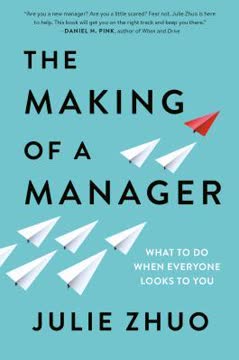Key Takeaways
1. Understand and support your team's core needs
Our core needs are exactly that: needs that must be met in order for us to feel safe and secure.
BICEPS framework. The BICEPS framework outlines six core needs in the workplace: Belonging, Improvement/Progress, Choice, Equality/Fairness, Predictability, and Significance. Understanding these needs helps managers comprehend why team members react differently to various situations.
Individualized approach. Recognize that each team member may prioritize different core needs. Use one-on-one meetings to gather insights about each individual's preferences, work styles, and motivations. This information enables managers to tailor their support and create a more effective team dynamic.
Addressing core needs. Actively work to meet these needs by:
- Fostering a sense of belonging through team-building activities
- Providing opportunities for skill development and career growth
- Offering choices in work assignments and processes
- Ensuring fair treatment and transparent decision-making
- Maintaining consistent communication and predictable routines
- Recognizing individual contributions and their significance to the team
2. Master the four hats of leadership: mentoring, coaching, sponsoring, and feedback
Strong leaders understand the spectrum of communication styles and the energy they bring to work, and know when is best to embody or project each.
Mentoring. Share your experience and knowledge to guide team members through specific challenges. Use this approach when team members are new or facing unfamiliar situations.
Coaching. Ask open-ended questions and encourage self-reflection to help team members develop their own problem-solving skills. This approach is ideal for fostering long-term growth and leadership development.
Sponsoring. Actively promote team members for new opportunities, challenging assignments, and career advancements. This is crucial for helping individuals grow within the organization and is especially important for underrepresented groups.
Feedback. Provide specific, actionable feedback using the following structure:
- Observation: State the behavior without judgment
- Impact: Explain the effect of the behavior
- Question or Request: Ask for their perspective or suggest a change
Balance these four approaches based on each team member's needs and the situation at hand. Regularly reassess and adjust your leadership style to ensure continued effectiveness.
3. Set clear expectations for roles, vision, and team practices
Clarity around these expectations can help meet your teammates' Predictability, Belonging, and Equality/Fairness core needs.
Define roles and responsibilities. Use tools like RACI matrices or Venn diagrams to clearly outline each team member's responsibilities. This reduces confusion and helps prevent conflicts over task ownership.
Establish team vision and priorities. Collaboratively develop a team charter that includes:
- Vision: The team's long-term aspiration
- Mission: The team's role in achieving the vision
- Strategy: How the team will accomplish its mission
- Objectives: Measurable goals to track progress
Document team practices. Create and maintain documentation for:
- Meeting schedules and purposes
- Communication channels and norms
- Collaboration processes
- Decision-making procedures
Regularly review and update these documents with input from the team to ensure they remain relevant and effective. This collaborative approach fosters a sense of ownership and alignment among team members.
4. Communicate strategically during organizational changes
As a front-line manager, you will be continually tasked with communicating information to your team as the organization around you evolves.
Develop a communications plan. Create a structured approach for sharing important information:
- Background: What is changing and why
- People: Who is affected and who needs to know
- Timeline: When and how information will be shared
- Talking points: Key messages to convey
Choose appropriate mediums. Select the right communication channel based on the message's complexity and sensitivity:
- In-person meetings for sensitive or complex information
- Email for documenting decisions and sharing factual updates
- All Hands meetings for company-wide announcements
Repeat key messages. Understand that people rarely remember information the first time they hear it. Reinforce important points through multiple channels and over time.
Adapt your communication style. Learn to adjust your tone and energy to suit different situations and audiences. Develop a range of communication approaches, from empathetic to directive, to effectively navigate various organizational challenges.
5. Build resilience for yourself and your team during crises
As managers, one of our responsibilities is to provide the safest workplace we can to those around us.
Prepare in advance. Take proactive steps to build team resilience:
- Familiarize yourself with company support resources (e.g., EAP, legal assistance)
- Lead by example in self-care and work-life balance
- Establish clear processes for time off and deadline adjustments
Support during crisis. When a crisis occurs:
- Recognize signs of distress in team members
- Offer support without being intrusive
- Collaborate on adjusting workloads or deadlines as needed
- Communicate company-wide support and resources available
Foster psychological safety. Create an environment where team members feel safe to express concerns and ask for help. This includes:
- Encouraging open dialogue about challenges
- Validating emotions without judgment
- Providing flexibility in work arrangements when possible
- Regularly checking in on team members' well-being
6. Manage your energy and learn to delegate effectively
The best gift you can give your teammates is a messy, hard-to-measure, unscoped project.
Track energy levels. Monitor how different tasks and meetings affect your energy:
- Color-code calendar events based on the type of mental energy required
- Identify patterns in energy fluctuations throughout the week
- Adjust scheduling to optimize productivity and reduce fatigue
Prioritize tasks. Use the Eisenhower matrix to categorize tasks:
- Urgent and important: Do immediately
- Important but not urgent: Schedule for later
- Urgent but not important: Delegate
- Neither urgent nor important: Eliminate
Delegate strategically. Empower team members by delegating challenging projects:
- Choose tasks that stretch their abilities and foster growth
- Provide a safety net of support without micromanaging
- Use the RACI framework to clarify roles and expectations
Learn to say no. Protect your time and energy by declining non-essential commitments:
- Align tasks with team and organizational priorities
- Develop templates for gracefully declining requests
- Seek accountability from peers or mentors in saying no more often
7. Cultivate a diverse support network for personal growth
As you grow your own support network, I recommend that you always be on the lookout for people who will push you out of your comfort zone, have different levels of experience than you do (both more and less!), have experience in a different industry, and are good at the things that you're terrible at.
Build a "Manager Voltron". Assemble a diverse group of supporters who can provide different perspectives and skills:
- Mentors with more experience in your field
- Peers facing similar challenges
- Experts in areas where you lack knowledge
- Coaches for specific skill development
Expand your network. Actively seek out new connections:
- Attend industry events and meetups
- Participate in online communities and forums
- Give talks or presentations to attract like-minded professionals
Engage strategically. When reaching out to potential supporters:
- Identify specific topics or challenges you'd like to discuss
- Explain why you value their perspective
- Make it easy for them to engage by suggesting a clear, time-limited interaction
Reciprocate support. Offer your own expertise and assistance to others in your network. This helps build stronger relationships and creates a culture of mutual growth and support within your professional community.
Last updated:
FAQ
What’s "Resilient Management" by Lara Hogan about?
- Practical guide for managers: "Resilient Management" is a hands-on book that helps new and experienced managers navigate the human side of leading teams, especially in tech and creative industries.
- Focus on team dynamics: The book centers on understanding, supporting, and growing teams through the inevitable cycles of change, friction, and uncertainty.
- Emphasis on resilience: Hogan provides frameworks and tools for building resilience in both managers and their teams, preparing them for organizational shifts and personal challenges.
- Human-centered leadership: The book prioritizes empathy, trust, and clear communication as the foundation for effective management.
Why should I read "Resilient Management" by Lara Hogan?
- Actionable management tactics: The book offers concrete tools, questions, and frameworks you can immediately apply in your management practice.
- Addresses real-world challenges: Hogan tackles common pain points like giving feedback, setting expectations, and handling organizational change.
- Focus on personal growth: It helps managers understand their own needs and styles, making them more effective and authentic leaders.
- Builds resilient teams: The advice is designed to help you foster trust, clarity, and adaptability within your team, leading to better performance and well-being.
What are the key takeaways from "Resilient Management" by Lara Hogan?
- Stages of team development: Teams cycle through Forming, Storming, Norming, and Performing, and managers must adapt their approach at each stage.
- BICEPS core needs: Understanding and addressing the six core human needs at work (Belonging, Improvement, Choice, Equality, Predictability, Significance) is crucial for team health.
- Four management hats: Effective managers balance mentoring, coaching, sponsoring, and giving feedback, rather than defaulting to just one mode.
- Clarity and communication: Setting clear expectations, documenting roles, and communicating transparently are essential for team resilience and trust.
How does Lara Hogan define and use the BICEPS core needs in "Resilient Management"?
- Six core needs: BICEPS stands for Belonging, Improvement/Progress, Choice, Equality/Fairness, Predictability, and Significance—each representing a fundamental workplace need.
- Individual differences: Not everyone values each need equally; managers must learn which needs matter most to each teammate.
- Impact on behavior: When a core need is threatened, people may react strongly or unpredictably, so understanding BICEPS helps managers interpret and address these reactions.
- Practical application: Hogan encourages managers to discuss BICEPS openly with their teams and use it to guide support, feedback, and change management.
What are Tuckman’s stages of group development, and how are they applied in "Resilient Management"?
- Four stages explained: The stages are Forming (team comes together), Storming (friction and conflict arise), Norming (processes and relationships stabilize), and Performing (team operates at high effectiveness).
- Cyclical process: Teams revisit these stages whenever there’s a change, such as new members, shifting goals, or reorgs.
- Management strategies: Hogan provides tailored advice for supporting teams at each stage, from building trust in Forming to setting norms in Norming.
- Diagnosing team health: Recognizing which stage your team is in helps you choose the right interventions and support.
How does Lara Hogan recommend managers get to know their team members in "Resilient Management"?
- First 1:1 questions: Hogan suggests a set of lightweight, open-ended questions covering grumpiness triggers, feedback preferences, recognition styles, goals, and support needs.
- Documenting insights: Managers are encouraged to keep notes on each teammate’s answers to personalize support and assignments.
- Sharing management style: Managers should also articulate and share what they’re optimizing for, so teammates know what to expect.
- Ongoing curiosity: Building trust and understanding is an ongoing process, not a one-time event.
What are the four key management skills (mentoring, coaching, sponsoring, feedback) in "Resilient Management," and how should they be balanced?
- Mentoring: Sharing advice and experience to help teammates solve problems, especially when they’re new or stuck.
- Coaching: Asking open questions and reflecting to help teammates introspect and develop their own solutions, fostering deeper growth.
- Sponsoring: Advocating for teammates behind the scenes, putting their names forward for opportunities and visibility.
- Feedback: Delivering specific, actionable, and well-structured feedback to help teammates improve; Hogan introduces the "feedback equation" for this.
- Dynamic balance: Managers should consciously choose which skill to use based on the teammate’s needs and context, rather than defaulting to just one.
How does "Resilient Management" by Lara Hogan advise managers to set clear expectations and document team processes?
- Roles and responsibilities: Use tools like RACI matrices and Venn diagrams to clarify who does what, reducing ambiguity and overlap.
- Team vision and priorities: Collaboratively define and document the team’s vision, mission, strategy, and objectives, tying them to company goals.
- Team practices: Document recurring meetings, communication channels, and collaboration norms in a central, accessible place.
- Living documents: Treat all documentation as evolving, updating it regularly and involving the team in improvements.
What communication strategies does Lara Hogan recommend in "Resilient Management" for managers facing organizational change?
- Communication planning: Use structured communication plans (who, what, when, how) for sensitive or complex news, anticipating team reactions.
- Medium matters: Choose the right channel (meetings, emails, All Hands) based on the message’s nuance and emotional impact.
- Repeat and adapt: Important messages should be repeated across multiple channels and tailored to different audiences for better absorption.
- Transparency and empathy: Be as transparent as possible, address core needs, and prepare for emotional responses, especially during uncertainty.
How does "Resilient Management" help managers build resilience in themselves and their teams?
- Crisis preparation: Know your company’s support resources, set clear expectations, and lead by example in self-care and flexibility.
- Managing energy: Track and analyze your own energy levels, group similar tasks, delegate, and say no when necessary to avoid burnout.
- Delegation as growth: Give teammates challenging, ambiguous projects to help them grow and free up your own capacity.
- Support networks: Build a "Manager Voltron" of peers, mentors, and supporters inside and outside your organization for advice and emotional support.
What are the most actionable tools and frameworks from "Resilient Management" by Lara Hogan?
- BICEPS core needs: Use this framework to understand and address individual and team motivations.
- Feedback equation: Structure feedback as observation, impact, and request/question for clarity and effectiveness.
- RACI matrix and Venn diagrams: Clarify roles and responsibilities for projects and teams.
- Communication plan template: Plan and execute sensitive communications with forethought and empathy.
- Eisenhower matrix: Prioritize and delegate tasks based on urgency and importance to manage workload and energy.
What are the best quotes from "Resilient Management" by Lara Hogan and what do they mean?
- “Growth is beautiful, growth is magnificent, growth is what we should be aiming for. But in actuality, growth is painful. We get goopy.” — Growth as a manager is messy and uncomfortable, but it’s necessary for transformation.
- “You’re optimizing for balance, not perfection.” — Managers should focus on creating a healthy, adaptable team environment, not on flawless execution.
- “The absence of trust is the foundation of most team dysfunction.” — Building and maintaining trust is the most critical job of a manager.
- “Give away your Legos.” — Delegating meaningful work to others is essential for both your growth and theirs, even if it feels risky.
- “Disagreeing and committing is the most mature and transparent move you can make.” — Even when you don’t fully agree with a decision, supporting it for the good of the team and organization is a mark of strong leadership.
Review Summary
Resilient Management is highly praised for its practical advice on leadership and team management. Readers appreciate Lara Hogan's concise, actionable guidance, especially for new managers. The book covers topics like understanding team dynamics, coaching, communication, and maintaining resilience. Many reviewers found the BICEPS framework particularly valuable. While some experienced managers felt it reinforced known concepts, most agreed it's an excellent resource for both new and seasoned leaders. The book's brevity and focus on human-centered management were frequently highlighted as strengths.
A Book Apart Series Series
Similar Books










Download PDF
Download EPUB
.epub digital book format is ideal for reading ebooks on phones, tablets, and e-readers.








